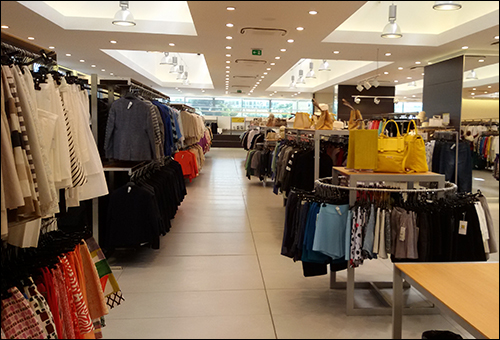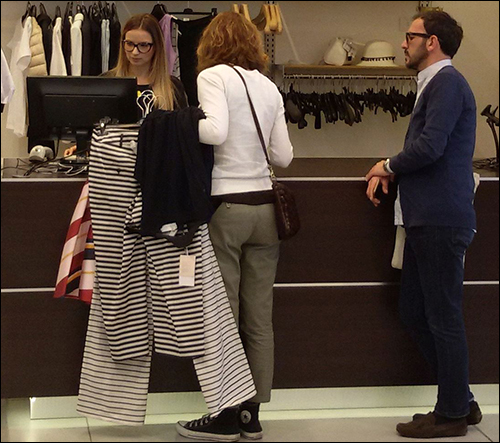Diffusione Tessile (DITE), the factory outlet division of fashion retailer Max Mara Group, is employing an RFID-based real-time location system (RTLS) to reduce lines at its service counter and ensure that customers can find the products they seek. The system, installed at the company’s high-volume Pomezia store (near the city of Rome), was provided by ID Solutions SRL, a spinoff company of the University of Parma’s RFID Lab. The solution includes 13 EPC Gen 2 ultrahigh-frequency (UHF) RFID readers linked to a total of 254 antennas via multiplexers. ID Solutions’ RFID middleware captures the data and forwards it to a Web application available to store associates.
The system was designed as part of the EU-funded, RFID-based Sensor-Enabled, Real-world Awareness for Management Information System (SERAMIS) project. SERAMIS has been working to foster the real-world use of RFID systems in Italy for the past two years, and DITE (which has declined to comment for this story) is a member of the project consortium.

While many retailers use passive UHF RFID tags to track the movements of goods at key locations via portal readers, utilizing an RTLS solution to track those tagged goods in stores is less common. Retailers that employ RFID often know when goods were received—and, in some cases, when they are purchased—based on EPC UHF tag reads, but conducting inventory counts of merchandise on the the sales floor still tends to require that an employee periodically walk around the store with a handheld reader.
The RTLS solution being used by Diffusione Tessile is the result of exhaustive research and testing at the University of Parma’s RFID Lab, says Antonio Rizzi, an industrial logistics and supply chain management professor at the university. The Diffusione Tessile situation is uniquely challenging and serves as a good test case for RTLS technology, says Rizzi, who will describe the project in detail this week’s RFID Journal LIVE! conference and exhibition, during a presentation on May 3. The DITE store in Pomezia is large—about 20,000 square feet, with 15,000 products on the sales floor at any given time, and another 40,000 or more in the back room. Several hundred customers shop there daily, and the store is open seven days a week, 12 hours a day. Customers often struggle to locate the exact items they seek. The retailer estimates that before RFID was in place, up to 10 percent of sales were lost due to customers simply not finding products that were, in fact, available in the store.
A single sales desk is dedicated for customer questions, and a queue often forms at that desk, while customers wait to inquire whether different sizes or colors are available, or where specific items can be found in the store. In many cases, a sales associate working at the desk has had to enter the back room and physically search for an item that a customer could not find on the sales floor. In the meantime, the queue could become longer and the customer, left alone, might leave the store.
The store could use a handheld reader to provide more accurate inventory on the sales floor. Because the site is so large, however, inventory checks with handheld readers would require one to two hours of employee labor.
To improve its inventory accuracy, DITE began piloting UHF RFID technology in 2014 at four of its stores (including the one in Pomezia), as well as at its distribution center in northern Italy, to track tagged merchandise via RFID portals and handheld readers. That system consisted of Impinj readers that captured tag reads in the back room as goods were received, in the aisles that divide the back room from the sales floor, and at the point of sale, as well as Zebra MC3190-Z handhelds that employees periodically used to count inventory.
In 2015, the company began planning to test and deploy RTLS technology for the first time at the Pomezia store, in order to increase its visibility into the locations of goods in real time.

ID Solutions divided the Pomezia store into 29 read zones in which tagged merchandise was displayed in various cabinets, as well as on shelves, racks and counters. The antennas that read tags could then enable the software to identify the specific zone in which each tagged item is located.
To determine a tag’s location within a particular zone, the system uses received signal strength indicator (RSSI), as well as tag rate read (how many times a particular tag is interrogated during a specified period of time). The higher a tag’s rate for a given antenna, the closer the tag is determined to be to that antenna. ID Solutions’ middleware then triangulates the data to locate an item on the store map.
Smartrac Web Ucode 7 tags are attached to garments at the DC. For the RTLS solution, the Pomezia store has 13 Impinj Speedway Revolution R440 four-port readers installed in the ceilings, wired to a total of 253 Laird far-field circular polarized UHF reader antennas via multiplexers. Due to the high volume of readers and antennas, as well as the large numbers of tag reads, ID Solutions designed the system so that each reader has approximately three to five minutes of read time before going to sleep and allowing the next reader to begin interrogating tags. The result is that the entire store is read once every half-hour. “This strategy, compared to more frequent reader on-off cycles, definitely allows us to increase inventory accuracy,” Rizzi states.
ID Solutions’ RFID System Administrator software collects the read data and determines each tagged item’s location, indicating its zone. Each product’s tag ID is then linked in the software with the specific product’s details, such as a garment’s style, size and color.
The software comes with a Web user interface so that sales associates can pinpoint where garments are located by viewing details on their computer screen. Employees in the back room can also view that information as they determine what needs to be replenished.
In addition, the store has been using Impinj RFID readers at its checkout counters since 2014. In this case, a reader is built into a bin into which tags are placed after being removed from purchased garments. When the bin reader captures those products’ tag IDs, the system knows that those goods have been purchased, and can add them to the list of items requiring replenishment.
The store employs individuals known as runners who are dedicated to moving items from the back room to the sales floor, as needed. At the service desk, when a shopper requests a specific item, the associate inputs that product’s description into the ID Solutions software. The RTLS data then provides a view into the zone in which that item can be found, based on the RFID tag read. If the product is found to be in the back room but not on the sales floor, the associate uses the software to issue an alert to the runner on duty, who views a request on his or her tablet. The runner then simply locates that item in the back room and brings it to the service desk, while the associate at the desk can continue assisting customers. This tool itself makes the RTLS solution worthwhile, Rizzi says, since it enables greater product sales and more satisfied customers, while freeing up the associate to work with other customers.
“The main benefit is a huge increase in sales associate productivity,” Rizzi states.
Although the RTLS technology was installed in early 2015, another nine months of reconfiguring were required to fine-tune location and inventory count algorithms, and to identify the best positioning for antennas. The first test took place in October 2015 with several hundred tagged products, followed by a more extensive test of several thousand items in December, with cross-checking of the system accomplished via handheld readers.
Testing determined that inventory accuracies were, on average, 98.25 percent or higher, while location accuracy—indicating that an item is in the zone where, in fact, it truly is—is about 99.4 percent. Only a few tagged items were actually identified as being in the wrong location, but some products’ tags were never interrogated by the RTLS readers.
Diffusione Tessile’s management is still evaluating whether it will roll out the RTLS solution at all 25 of its stores. The company hopes to find that the system leads to an increase in sales by ensuring that visibility into location and inventory makes all styles, colors and sizes of garments available for customers to buy.


